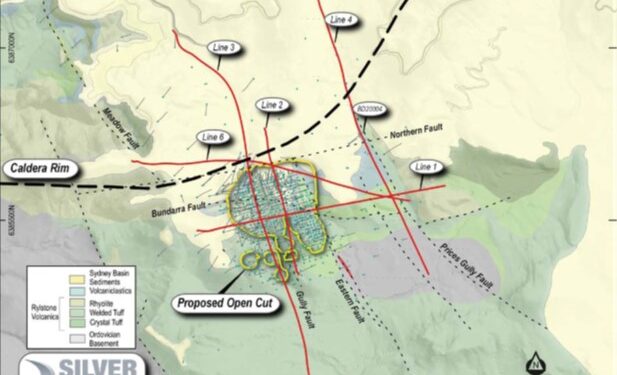Silver Mines Limited (ASX:SVL) has identified a number of new targets and further highlighted the exploration potential of the Bowdens Silver Project located near Mudgee in New South Wales.
During the March 2022 quarter, VelSeis Pty Ltd were engaged to complete a programme of 2D seismic reflection surveying across the Bowdens Silver Deposit and local geological area. The survey consisted of 12.44 line-kilometres and was aimed at determining the seismic response of the Bowdens Deposit, identify potential extensions to the system both down plunge and dip at depth, and also highlight possible “analogue” responses within prospect areas such as Prices Gully.
The company has worked in understanding the formation and geological setting of the Rylstone Volcanics and Bowdens Mineral Deposit, and seismic surveying is well suited to understanding the volcanic rocks and structural framework of what is now clearly defined to be the “Bowdens Caldera”.
The seismic survey is a key component of the company’s research and development programme which will integrate all data and accelerate ore discovery through predictive modelling.
Seismic Data
The footprint of the Bowdens System is clearly defined in the seismic survey Lines 3 and 1. Mineralisation within the proposed open pit show as anomalously high amplitude and flat lying reflectors.
Current geological models match well with seismic responses and key geological boundaries such as the Rylstone Volcanic and Coomber Formation basement contact, the Rylstone Volcanic and Sydney Basin contact, and the main pyroclastic units which host the Bowdens Deposit mineralisation can be extended at depth significantly. To the north of the Deposit, the existence of additional volcanic sequences deposited after the Bowdens pyroclastics (crystal and welded tuffs) are evident.
Targeting
Three target types have been identified: Bowdens analogues, system extensions and steep “ring fault” hosted targets. Line 1 has two high priority targets in Prices Gully, less than a kilometre east of the Bowdens Deposit. These show the characteristic high amplitude surface reflectors, cut by listric faults, much like at Bowdens.
Line 3 shows the potential continuation at depth of the Northwest and Aegean Zones while also highlighting a series of faulted, strong reflectors 600 metres to the south of the Bowdens Deposit and at shallow depth.
The largest targets are on Line 3 and Line 4, north of the Bowdens Deposit and north of an intercept in BD20004 of 0.9 metres at 128g/t silver equivalent. These targets are interpreted as an extensive and deep fault formed by caldera collapse (a volcanic structure outlined below) known as a ring fault.
This ring fault, connects to the Northern fault at depth, is the location of the greatest displacement in stratigraphy, marking the southern boundary of a large volcanic centre, or caldera. These faults can be the key driver of fluid migration in epithermal deposits such as the Round Mountain Gold Deposit in Nevada and the Banská Hodruša Gold Deposit in Slovakia.
About the Bowdens Silver Project
The Bowdens Silver Project is located in central New South Wales, approximately 26 kilometres east of Mudgee. The consolidated project area comprises 2,007 km2 (496,000 acres) of titles covering approximately 80 kilometres of strike of the highly mineralised Rylstone Volcanics.
Multiple target styles and mineral occurrences have potential throughout the district including analogues to Bowdens Silver, high-grade silver-lead-zinc epithermal and volcanogenic massive sulphide (VMS) systems and copper-gold targets.
Bowdens Silver is the largest undeveloped silver deposit in Australia with substantial resources and a considerable body of high-quality technical work already completed. The projects boast outstanding logistics for future mine development.
For further information please visit: https://www.silvermines.com.au/












